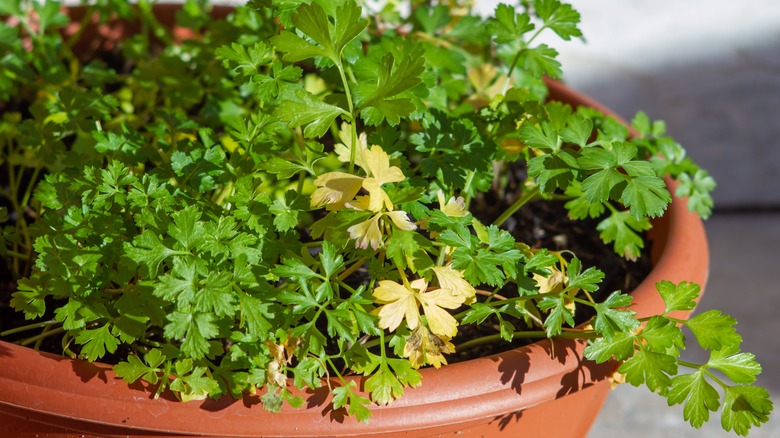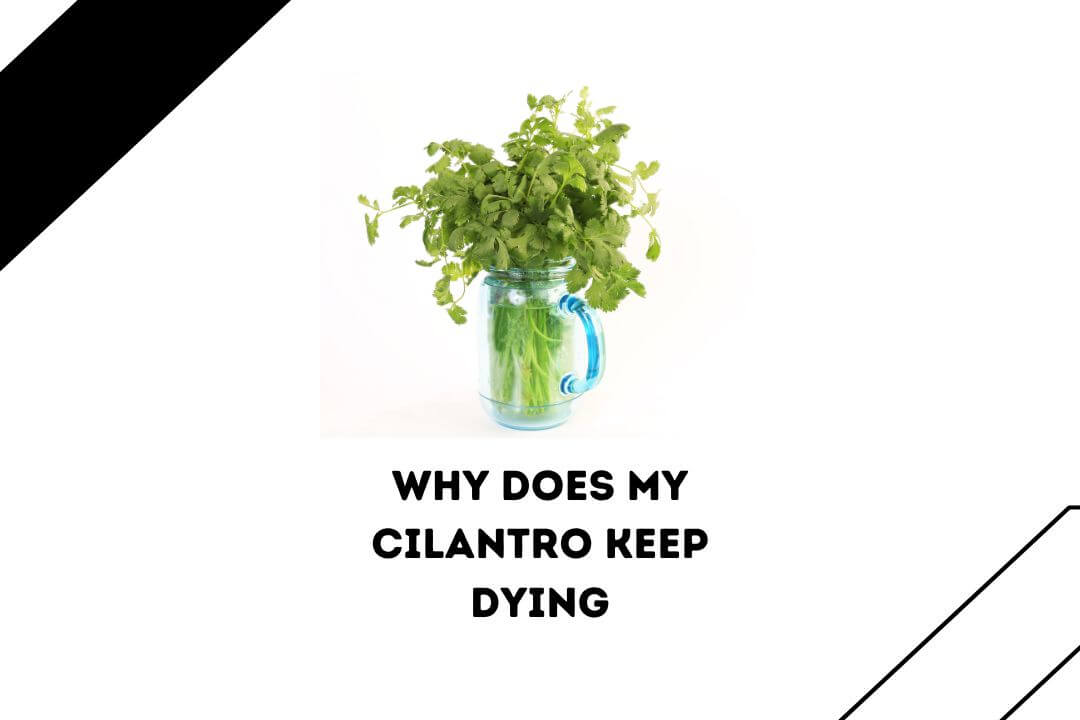Cilantro also known as coriander, is a popular herb used in many cuisines around the world. However cilantro has a reputation for being difficult to grow and prone to bolting or dying unexpectedly. If your cilantro keeps wilting and dying prematurely, don’t despair. By understanding the common causes and implementing a few best practices, you can have a thriving cilantro plant.
Common Causes for Dying Cilantro
There are several key reasons cilantro often struggles to thrive:
Inadequate Sunlight
Cilantro needs at least 6 hours of direct sunlight per day. With insufficient light, the stems become long and leggy as the plant reaches for sunlight, making them weaker and more prone to toppling over. The foliage may also turn yellow or brown without enough sun exposure.
Extreme Temperatures
Cilantro prefers daytime temperatures between 60-85°F. In very hot climates, afternoon shade is recommended to prevent bolting Temperatures below 55°F or frequent frost will also cause cilantro to bolt and die back
Improper Watering
Cilantro needs consistently moist soil. Both under and overwatering leads to poor growth and death. The leaves can wilt from drought or rot from oversaturation.
Premature Flowering
Once cilantro flowers and goes to seed, the flavor deteriorates. The plant then dies back after producing seeds. Frequent pruning and ideal growing conditions prevent bolting.
Small Containers
Cilantro planted in pots less than 10 inches wide often struggle to thrive and bolt more readily. Roots require sufficient room to grow.
Poor Drainage
Excess moisture with poor drainage causes root rot. Cilantro needs well-draining soil that holds some moisture.
Nutrient Deficiencies
With insufficient nitrogen, phosphorus, and potassium, the leaves can turn yellow and growth stalls. Occasional fertilization is recommended.
Shock from Transplanting
Cilantro grown in ideal nursery conditions suffers transplant shock when environmental factors like temperature, sunlight, and soil changes. Gradual acclimation prevents shock.
Pests Like Aphids
Sucking insects deplete nutrients and spread disease. Scout for signs of infestation and apply organic treatments promptly.
By understanding why cilantro often struggles, you can take steps to address the underlying causes.
How to Keep Cilantro from Dying
With the right growing conditions and care, cilantro can thrive! Follow these tips for healthy, long-lasting plants:
-
Sun and Temperature: Grow cilantro in full sun avoiding hot afternoon light in warm climates. Maintain daytime temperatures between 60-75°F. Move pots to optimize sun exposure.
-
Watering: Water at the base of plants when the top 1-2 inches of soil become dry. Soil should be moist but not soggy. Add mulch to retain moisture.
-
Soil: Plant cilantro in rich, well-draining soil high in organic matter. Amend clay or sand with compost.
-
Container Size: For potted cilantro, use containers at least 10-12 inches wide with drainage holes. This prevents root binding.
-
Fertilizing: Apply balanced liquid fertilizer every 2-3 weeks during the growing season if soil lacks nutrients.
-
Pruning: Prune often by cutting each stem down to 6-8 inches. This prevents bolting and extends harvests.
-
Weeding: Keep planting areas and containers free of weeds which compete for water and nutrients.
-
Pest Control: Check weekly for aphids and other pests. Remove by hand or use insecticidal soap sprays.
-
Growing Indoors: Provide at least 6 hours of direct sunlight from a south facing window. Use grow lights to supplement.
-
Transplanting: Harden off indoor grown transplants for 7-10 days. Transplant on an overcast day into pre-watered soil.
-
Avoid Shock: Make environmental shifts like repotting, light changes, and watering gradual.
-
Harvest Often: Cutting leafy top growth promotes more tender new growth but prevents flowering.
With the right care, your cilantro will thrive! Pay close attention to sunlight, water, drainage, container size, and harvesting to keep plants actively growing. By preventing flowering and environmental shocks, you’ll have an abundance of cilantro for months.
Troubleshooting Specific Issues with Dying Cilantro
If your cilantro still struggles, observe the symptoms closely to pinpoint and address the underlying issue:
Wilting or Drooping Leaves
- Cause – Underwatering, drought, heat stress, or shock
- Solution – Move plant to shade, increase watering frequency, use mulch
Yellow or Brown Leaves
- Cause – Sunscald, poor drainage, overwatering, or nutrient deficiency
- Solution – Adjust sunlight, amend soil, allow soil to dry between watering, fertilize
Leggy Growth
- Cause – Insufficient sunlight or overcrowding
- Solution – Move plant or use grow lights to increase light. Thin crowded plants.
Flowering and Bolting
- Cause – Mature plant, heat stress, or small container
- Solution – Prune immediately and harvest remaining leaves. Plant in larger pot.
Rotting Stems and Foliage
- Cause – Overwatering, high humidity, or disease
- Solution – Allow soil to dry between waterings. Improve airflow and isolate diseased plants.
Stunted Growth
- Cause – Cold temps, transplant shock, or pests
- Solution – Protect from frost, harden off transplants, eliminate pests
White Powdery Substance on Leaves
- Cause – Powdery mildew fungal disease
- Solution – Improve airflow. Use neem oil or fungicides.
Frequently Asked Questions
Still have questions about preventing your cilantro from dying? These common FAQs provide helpful answers:
How often should cilantro be watered?
Cilantro should be watered whenever the top 1-2 inches of soil become dry. Water thoroughly until it drains from the pot. Frequency depends on container size, temp, and soil but is often every 1-3 days.
Should cilantro be fertilized?
Applying liquid fertilizer every 2-3 weeks provides nutrients for optimal growth, especially if soil is lacking. Use a balanced 10-10-10 or fish emulsion.
When should I harvest cilantro?
Begin harvesting leaves once the plant is at least 6 inches tall. Cutting often generates continuous leaf production. Harvest in the morning after dew dries.
How much sunlight does cilantro need?
Cilantro requires at least 6 hours of direct sun daily. Morning sun is ideal in hot climates to prevent bolting. Supplement with grow lights indoors.
What size pot does cilantro need?
For potted cilantro, use containers at least 10-12 inches wide, allowing at least 6 inches between plants. Larger pots yield more before bolting.
Can I grow cilantro indoors?
Yes! Provide at least 6 hours of sunlight via a south facing window or grow lights. Maintain temps between 65-75°F. Grow in well-draining potting mix with drainage holes.
Why is my cilantro flowering?
Cilantro flowers and bolts after maturing or when stressed by heat, drought, small containers, or a lack of nutrients. Prolong harvest by pruning frequently.
What causes cilantro leaves to turn yellow?
Yellow leaves often indicate overwatering, saturated soil, insufficient sunlight, or nutrient deficiencies. Address the underlying cause and prune damaged foliage.
Enjoy Growing Flavorful Cilantro
Now that you understand what makes cilantro thrive or die back prematurely, you can take steps to grow bountiful crops of this delicious herb. Pay close attention to sunlight, hydration, container size, pruning, and harvesting. With the right care, you’ll have homegrown cilantro for tacos, salsas, curries, and other cuisine all season long. Happy gardening!
Dealing with an adverse growth environment

To rescue your dying cilantro plant, you must first assess its growing conditions. Being a cool-season herb, cilantro leaves can wilt prematurely when exposed to harsh sunlight. Moving the plant to a partially shaded spot and giving it only six hours of sun a day will help it grow back to its former lush glory. In the same way, cilantro doesn’t last as long when it’s hotter than 80 degrees Fahrenheit because the heat dries out the herb, making it less moist. To counter this, add mulch to the soil. Advertisement.
Because this plant’s water needs change over the course of its life, you need to be careful not to water it too much or too little. The easy way is to make sure that the top two inches of your soil are dry and only water it when that layer is dry. Avoid overwatering your plant, which could lead to root rot. On the other hand, cilantro leaves can turn brown if they don’t get enough water, so they need to be watered at least once a week and up to three times a week when it’s hot.
How to Grow Cilantro…And Stop It From BOLTING!
- A Complete Guide to Caring for Yuki Cherry Blossom Shrub - January 23, 2025
- Identifying Red Hot Poker Seeds: What to Look For When Harvesting Torch Lily Pods - January 23, 2025
- A Complete Guide to Harvesting Evening Primrose Seeds - January 23, 2025

